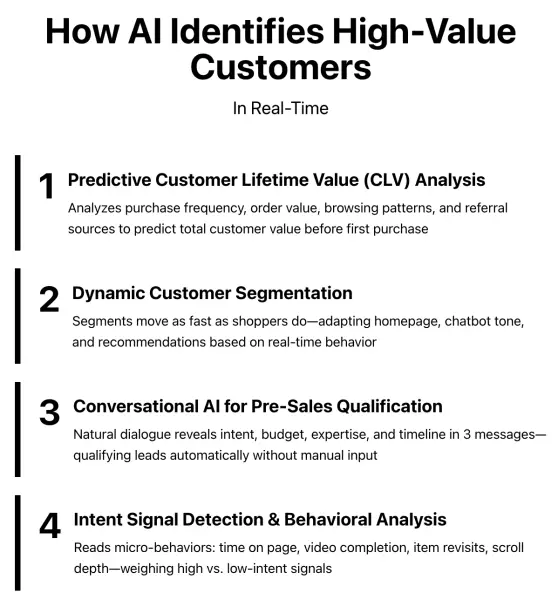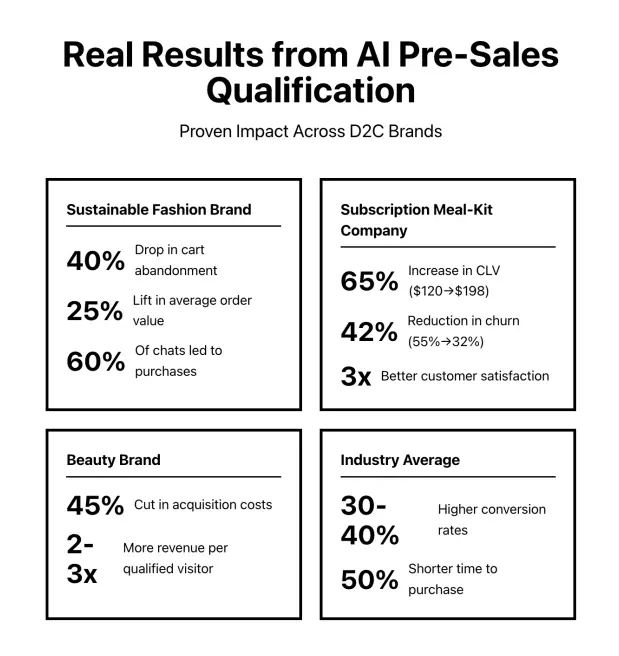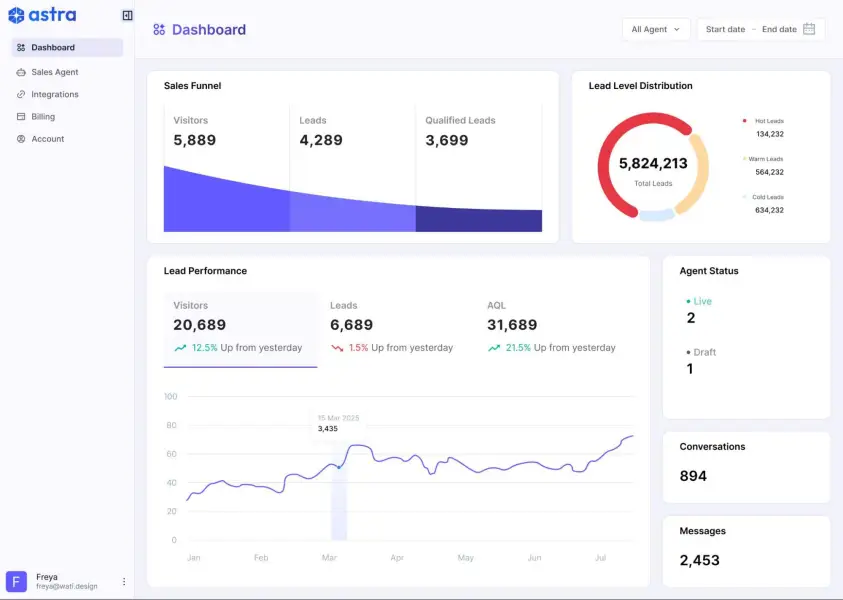
AI Pre-Sales Qualification: How D2C Brands Identify High-Value Customers in Real-Time?
Written by:
 Musa Bhat
|
on:
November 11, 2025
|
Last updated on:
November 12, 2025
|
According to: Editorial Policies
Musa Bhat
|
on:
November 11, 2025
|
Last updated on:
November 12, 2025
|
According to: Editorial Policies
Most D2C brands know how to drive traffic, but not how to tell who’s worth pursuing.
In a typical month, thousands of visitors browse your site, yet only a fraction buy. The rest scroll, compare, or vanish after one session. Treating every visitor the same means:
- Ad budgets chase the wrong audience
- Automation flows engage low-intent browsers
- High-value customers bounce due to generic messaging
- Discounts go to everyone, even those willing to pay full price
- Margins shrink while acquisition costs keep climbing
Most teams realize this only after a purchase, or after the customer leaves.
AI pre-sales qualification changes that. By reading real-time behavior: what people view, how long they stay, what they click, it predicts who’s most likely to convert and adjusts their experience automatically.
Ahead, you’ll see how D2C brands use AI to identify high-value customers before checkout, personalize their journey, and turn more traffic into revenue.

But first, a refresher.
What is AI Pre-Sales Qualification?
AI pre-sales qualification uses artificial intelligence to identify and prioritize your most valuable potential customers in real-time—while they’re still browsing your website.
Instead of waiting until someone makes a purchase (or doesn’t), AI analyzes hundreds of signals instantly: the pages visitors open, how long they stay, what they click, which products they view, the device they use, their location, and even the time of day they browse.
It then compares this real-time behavior with your historical customer data to answer a simple question: Do these behaviors match those of our best customers? From there, the system predicts how valuable each visitor could be to your business over time.
All of this happens in seconds, often within a visitor’s first few interactions on your site.
Traditional qualification waits for the transaction to happen, then looks back to analyze what worked. AI pre-sales qualification does the opposite: it identifies high-value visitors before they buy, personalizes their experience based on predicted value, and helps you focus resources on the right people from the start.
In short, post-purchase analysis looks in the rearview mirror; pre-sales qualification gives you the GPS.
How AI Identifies High-Value Customers in Real-Time?
AI uses four main methods to analyze behavior and predict customer value:

1. Predictive Customer Lifetime Value (CLV) Analysis
Customer lifetime value is the total profit a customer contributes over their entire relationship with your brand. AI predicts that value long before the first checkout happens.
It analyzes returning visitors through signals like purchase frequency, average order value, time between purchases, and product preferences. For new visitors, it looks at referral sources, landing pages, and early browsing behavior to find patterns that mirror your highest-value customers.
Browsing depth, repeat product views, and engagement signals, like arriving from an email versus a generic search, help refine those predictions. AI even accounts for context such as location, device type, or browsing time to find patterns specific to your customer base.
All of this feeds into a real-time CLV model that assigns each visitor a predicted value score as they browse, quietly informing how your website reacts next.
2. Dynamic Customer Segmentation
Traditional segmentation is static. AI segmentation moves as fast as your shoppers do.
When someone clicks on your premium products, AI flags them as high-value and reshapes their experience: the homepage shifts to feature luxury options, the chatbot adapts its tone, and recommendations adjust automatically. If that same visitor heads to your sales section, the system recalibrates.
It also tracks behavioral triggers: adding to cart, checking reviews, reading shipping details, and identifies which stage of the journey the person is in. Discovery visitors see education, consideration-stage visitors see comparisons, and decision-stage visitors see urgency or incentives.
3. Conversational AI for Pre-Sales Qualification
This is where tools like Astra come in. Conversational AI acts as your digital sales associate, qualifying leads through natural, two-way dialogue.
For example:
AI: “Hey! Looking for something specific or just browsing?”
Visitor: “I need running shoes for marathon training.”
AI: “Got it. What’s your budget?”
Visitor: “Around $200–$300.”
AI: “Perfect. Any brand or features you prefer?”
Visitor: “Good arch support and a carbon plate if possible.”
In three messages, the AI knows intent (serious buyer), budget (premium), expertise (experienced runner), and timeline (immediate). Astra’s qualification engine automates this entire flow, scoring leads in real time and routing them to the right next step without manual input.
4. Intent Signal Detection and Behavioral Analysis
Beyond conversations, AI reads the small cues that reveal how close someone is to purchasing.
High-intent signals include spending more than five minutes on a product page, watching videos to the end, revisiting the same items, or clicking size guides and reviews.
Low-intent signals include bouncing quickly, only viewing discounted items, or failing to scroll beyond the hero image.
AI weighs these micro-behaviors against historical purchase data to identify patterns that preceded your best customers, helping your brand recognize intent as it unfolds, not after it’s gone.
How AI Pre-Sales Qualification Process Actually Works?
Let’s walk through what happens when someone visits your D2C website with AI qualification enabled:
Step 1: Initial Engagement (0-5 seconds)
The process starts the moment a visitor interacts with your website—clicks a product, opens chat, or lands from an ad.
AI begins collecting behavioral data instantly: pages viewed, time spent, scroll depth, and device type. This early signal set forms the foundation of the visitor’s predictive profile.
Step 2: Real-Time Data Aggregation (5 seconds – 2 minutes)
As the visitor browses, AI continuously collects product views, page time, clicks, searches, and filters. It combines this with CRM data, purchase history, email engagement, and social interactions to create a complete, up-to-the-second profile.
Step 3: AI-Powered Qualification (Continuous)
The AI runs behavior through machine learning models trained on your customer data, predicting lifetime value, purchase probability, and churn risk. It outputs a qualification score that updates continuously as behavior changes.
Step 4: Automated Personalized Actions (Immediate)
Based on the score, the AI triggers specific actions:
- High-value prospects: Premium product display, Astra’s AI chatbot proactive engagement, personalized recommendations, VIP treatment
- Medium-value prospects: Bundle suggestions, subtle nudges, cart abandonment emails
- Low-value browsers: Self-service experience, email capture focus, entry-level products
Step 5: Continuous Learning (Ongoing)
After every visit or conversation, AI compares predicted outcomes with what actually happened. When a guess proves right, it strengthens the pattern. When it’s off, the model adjusts.
That feedback loop makes qualification sharper and conversion rates stronger week after week, without extra manual tuning.
How D2C Brands Use AI Pre-Sales Insights in Practice?
AI qualification is more than predicting value. It’s about using those predictions to change what the visitor sees, when they see it, and how your team responds.
Here are four ways AI quietly reshapes the pre-sales process, long before checkout happens.
Dynamic Pricing and Personalized Offer Optimization
AI helps brands balance persuasion with profit. It learns which shoppers are ready to buy, who’s still deciding, and who’s just browsing. Based on those patterns, it decides who truly needs an incentive and who doesn’t.
A sustainable fashion brand saw this firsthand. Using Astra’s conversational AI, the team intervened when shoppers added items to their carts but hesitated. The AI asked about fit, returns, and delivery time in real time, easing friction before checkout.
The results were significant: a 40% drop in cart abandonment, a 25% lift in average order value, and 60% of chat interactions leading to completed purchases.
By solving intent, not just offering discounts, the brand turned hesitation into conversion..
Intelligent Upsell and Cross-Sell Timing
AI shows recommendations strategically. For high-value customers: premium bundles and complementary products. For price-sensitive customers: entry-level alternatives and bundle deals. The AI also knows when to suggest add-ons, before checkout, during chat, or post-purchase, and tracks which recommendations work for different customer types.
A subscription meal-kit company used AI pre-sales qualification to screen prospects before signup. Instead of capturing anyone who clicked “Subscribe,” Astra asked simple, natural questions about cooking frequency, meal goals, and budget.
That quick exchange filtered out casual browsers and focused marketing spend on genuinely aligned customers. Within three months, average customer lifetime value increased from $120 to $198, churn dropped from 55% to 32%, and customer satisfaction improved dramatically.
Churn Prevention Through Early Warning Detection
AI also recognizes when engagement starts to fade: fewer visits, slower responses, longer gaps between purchases.
For high-value segments, Astra can trigger subtle recovery actions: a personalized product suggestion, a tailored reminder, or a proactive offer before the customer drifts too far.
In practice, these nudges cost less than re-acquisition campaigns and often double the chances of re-engagement.
Benefits of AI Pre-Sales Qualification for D2C Brands
For most D2C teams, growth usually means spending more: more ads, more headcount, more tools.
AI qualification breaks that equation. It lets brands scale smarter, not harder, by focusing on customers who already show the highest potential value.
- Increased Conversion Rates: When brands know who’s serious before checkout, conversion rates rise naturally.
D2C companies using AI qualification often see 30–40% higher conversions among high-value segments and 2–3x more revenue per qualified visitor.
It also shortens the time from first visit to purchase by half, because AI removes friction points: questions, hesitations, mismatched offers, before they slow momentum.
- Reduced Customer Acquisition Costs: Every click and conversation feeds back into your ad platforms. Over time, Meta and Google learn which profiles convert best and automatically optimize campaigns around them.
A beauty brand saw this compounding effect firsthand: after integrating AI pre-sales qualification, it cut acquisition costs by 45% while attracting customers who spent more and stayed longer.
- Improved Customer Experience: AI makes personalization feel intuitive rather than intrusive.
First-time visitors see educational content, starter bundles, or welcome discounts. Returning customers get quick reorders, loyalty perks, or tailored product suggestions.
Because the experience aligns with their stage in the journey, customers feel understood, without the brand having to guess.
- Scalability Without Proportional Cost Increases: AI doesn’t tire or need training.
Whether you’re qualifying 10,000 or 100,000 visitors a month, the same system keeps learning and improving without ballooning your overhead.
Instead of scaling through hiring, brands scale through intelligence, serving more visitors with the same team and budget while keeping response quality high.

How to Implement AI Pre-Sales Qualification?
Most D2C teams can start testing AI qualification within a day, using tools they already have in place. The key is connecting data, defining what “value” means for your brand, and letting the AI learn from there.
Tools You Need:
- AI Chatbot Platform (like Astra): Look for conversational AI that integrates easily, connects to your CRM, provides lead scoring, and allows customization. Astra offers a free plan to start—you can be up and running in under 10 minutes.
- CRM or Customer Data Platform: HubSpot (for SMBs), Salesforce (enterprise), or Klaviyo (e-commerce). The AI needs historical customer data to make accurate predictions.
- Website Analytics: Google Analytics for basic tracking, or Mixpanel/Amplitude for advanced event tracking.
Data Requirements:
- Minimum: 500 historical customers, 3-6 months of behavioral data, basic transaction data.
- Better: 1,000+ customers with multiple purchases, 12+ months of data, rich behavioral tracking, email engagement data, and support interactions.
Setting Up Your First Flow:
- Define your high-value customer: Be specific about what makes someone valuable: average order value, purchase frequency, product preferences, lifetime value thresholds.
- Identify qualification questions: “What’s your budget?” “How soon are you buying?” “What’s most important to you?”
- Train your AI agent: Using a tool like Astra, upload product information, set up qualification questions, define scoring, and configure actions for each segment. No-code setup takes about 30 minutes.
- Test and refine: Start small, watch performance, adjust based on what you learn.
- Scale across your site: Roll out to all landing pages, product pages, and cart flows once validated.
Turn Every Visitor Into an Opportunity With Astra
Here’s the bottom line: D2C brands can’t afford to treat every website visitor the same anymore.
Your best customers are worth 10x (or more) than your worst customers. But if you can’t tell who’s who when they land on your site, you’re leaving money on the table.
AI pre-sales qualification lets you identify high-value prospects in real-time, personalize experiences based on predicted value, focus resources on the people who matter most, reduce acquisition costs, and scale efficiently.
It reads intent in real time, highlights high-value prospects, and helps your site respond before customers drop off. The impact shows up fast: better conversions, lower acquisition costs, and fewer wasted clicks.
You don’t need a full rebuild to start. Add a conversational agent like Astra, connect your CRM, and let it qualify visitors as they browse. Within days, your data will feel sharper and your traffic will start working smarter.
Get started with Astra for free and start qualifying leads in minutes. Or book a demo to see how AI pre-sales qualification works for your specific business.
Your best customers are already visiting your site. Now you just need to identify them.

Frequently Asked Questions
Traditional lead scoring is reactive and rules-based. You collect data first (email, job title, company size), then manually score leads based on predetermined criteria. It happens after the fact and requires human intervention.
AI pre-sales qualification is predictive and happens in real-time. The AI analyzes behavior as it happens, compares it to historical patterns, and predicts future value instantly. It doesn’t need a form submission. It works the moment someone lands on your site.
Think of it this way: lead scoring is like grading a test after students turn it in. AI pre-sales qualification is like an adaptive test that adjusts difficulty based on how students perform in real-time.
Yes. In fact, small brands benefit the most because they have limited resources to waste on low-value customers.
Tools like Astra offer free plans to start. You don’t need enterprise budgets or custom development. Most modern AI qualification platforms are designed for SMBs with simple pricing and no-code setup.
The ROI usually shows up fast. If you’re spending money on ads or have sales staff following up with leads, even a 20% improvement in lead quality pays for itself quickly.
The AI primarily uses behavioral data that it collects automatically: pages viewed, time on site, products clicked, search queries, scroll depth, referral source, and device type.
If available, it also pulls in historical purchase data from your CRM, email engagement history, past support interactions, and previous website visits.
The AI can start working with minimal data and improve as it learns. You don’t need perfect data from day one. Even basic behavior tracking provides enough signals for the AI to start making predictions. For returning customers, the AI has richer data to work with.



Latest Comments